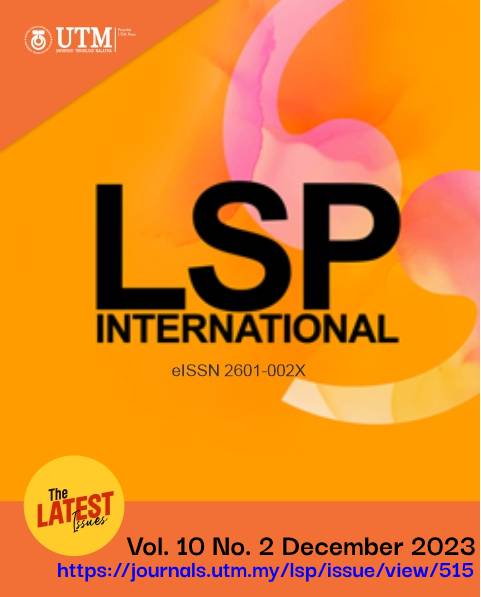A Case Study On the Use of Humorous Code-Switching in Harith Iskander’s Stand-Up Comedy Shows
DOI:
https://doi.org/10.11113/lspi.v10.20121Keywords:
Code-switch, Stand-up Comedy, Humour, Harith IskanderAbstract
Code-switching is a phenomenon where bilingual and multilingual speakers use two or more languages. Code-switching is a common situation in Malaysia due to the diversified cultural communities. However, little that we know how code-switching influences stand-up comedy shows. Hence, this paper explores the use of code-switching in stand-up comedy shows. Specifically, this paper explores the humorous code-switching that a comedian uses, the different linguistic types of code-switching used, and the conversational functions of code-switching. Data from this case study was collected by observing the stand-up comedy show from YouTube videos by one of the best Malaysian comedians, Harith Iskander. A total of ten YouTube videos were chosen where Harith used humorous code-switching to make the audience laugh. The data were analysed according to the objectives of this study The analysis revealed three types of humour that aligned with superiority theory: self-deprecating humour, disparaging others, and sarcasm. We found that ad-lib humour and funny comments aligned with the theory of incongruity. The analysis also revealed one humour that aligns with the relief theory. This study used Poplack’s (2008) three types of code-switching, namely tag-switching, inter-sentential switching, and intra-sentential switching. Based on Gumperz's (1982), six conversational functions, four of which have been identified in Harith Iskander's stand-up comedy shows: quotation, reiteration, message qualification, and personification versus objectification. This also suggests that humorous code-switching is invaluable for stand-up comedians and the audience, particularly those who are bilingual or multilingual.
References
Andeweg, B., Gagestein, S., de Jong, J., & Wackers, M. (2011). Poke fun at yourself’: The problem of self-deprecating humor. SEFl Conference Global Engineering Recognition, Sustainability and Mobility.
Al Heeti, N., & Al Abdely, A. A. (2016). Types and functions of code-switching in the English language used by Iraqi doctors in formal settings. International Journal of Advanced Research and Review, 1(8), 10-18.
Baker, C. (2011). Foundations of bilingual education and bilingualism. Multilingual matters.
Bakar, F., & Kumar, V. (2019). The use of humour in teaching and learning in higher education classrooms: Lecturers’ perspectives. Journal of English for Academic Purposes, 40, 15-25.
Berk, R. A. (2003). Professors are from Mars [R], students are from snickers [R]: How to write and deliver humor in the classroom and in professional presentations. Stylus Publishing.
Bryant, J., Comisky, P. W., Crane, J. S., & Zillmann, D. (1980). Relationship between college teachers' use of humor in the classroom and students' evaluations of their teachers. Journal of Educational Psychology, 72(4), 511.
Cook, V. (2016). Second language learning and language teaching. Routledge.
Department of Statistics, M. (2019). Current population estimates, Malaysia, 2018-2019 [Press release].
Eldridge, J. (1996). Code-switching in a Turkish secondary school. ELT Journal, 50(4), 303-311.
Garin, M. (2022). On Nintendo’s Visual Humour: slapstick cinema and comic theatre in super smash Bros. In Video games and comedy (pp. 93-112). Springer.
Goddard, C. (1994). The meaning of Lah: Understanding" Emphasis" in Malay (Bahasa Melayu). Oceanic Linguistics, 145-165.
Gruber, E. (2008). Humor in Contemporary Native North American Literature: Reimagining Nativeness. Camden House.
Gumperz, J. J. (1982). Discourse strategies. Cambridge University Press.
Halim, N. S., & Maros, M. (2014). The functions of code-switching in Facebook interactions. Procedia-Social and Behavioral Sciences, 118, 126-133.
Hamid, S. M. (2016). Code-switching between the teachers and the students of the conversation. Exposure, 5(2), 174-195.
Jingxia, L. (2010). Teachers’ code-switching to the L1 in EFL classroom. The Open Applied Linguistics Journal, 2(1).
Kawwami, A. M. (2015). Code switching used by the comics in stand up comedy show on Metro TV Universitas Islam Negeri Maulana Malik Ibrahim.
Lagerwerf, L. (2007). Irony and sarcasm in advertisements: Effects of relevant inappropriateness. Journal of Pragmatics, 39(10), 1702-1721.
Masruroh, S. A., & Rini, S. (2021). An analysis on forms and functions of code-switching and code-mixing used in drama performance. Jadila: Journal of Development and Innovation in Language and Literature Education, 1(4), 451-469.
Meyer, J. C. (2000). Humor as a double-edged sword: Four functions of humor in communication. Communication Theory, 10(3), 310-331.
Moghadam, S. H., Samad, A. A., & Shahraki, E. R. (2012). Code Switching as a medium of instruction in an EFL classroom. Theory & Practice in Language Studies, 2(11).
Muthusamy, P. (2010). Codeswitching in communication: A sociolinguistic study of Malaysian secondary school students. Pertanika Journal of Social Science and Humanities, 18(2), 407-415.
Nadia, H. (2014). Code-switching in stand-up verbal humour. International Journal of Research in Humanities, Arts and Literature, 2(8), 13-20.
Nesi, H. (2012). Laughter in university lectures. Journal of English for Academic Purposes, 11(2), 79-89.
Nor, M. M., & Shangeetha, R. (2023). Code-switching in Malaysian stand-up comedy performances: A case study of comedian Harith Iskander. Kajian Malaysia, 41(1), 109-132.
Poplack, S. (2008). Code-switching. In Volume 1 (pp. 589-596). De Gruyter Mouton.
Romaine, S. (2012). The bilingual and multilingual community. The handbook of bilingualism and multilingualism, 443-465.
Rullyanti, M., & Nurdianto, N. (2019). Language style of humor on stand-up comedy video. Journal of Applied Linguistics and Literature, 4(1), 60-68.
Shivaprasad, M. (2020). Humour and the margins: Stand-up comedy eand caste in India. Reference Source.
Stapa, S. H., & Khan, N. N. B. S. (2016). Functions of code-switching: A case study of a mixed Malay-Chinese family in the home domain. Pertanika Journal of Social Sciences & Humanities, 24(3), 181-194.
Stylianou-Panayi, N. (2015). Code switching in an EFL environment. Linguistics and Literature studies, 3(6), 259-263.
Wanzer, M. B., Frymier, A. B., & Irwin, J. (2010). An explanation of the relationship between instructor humor and student learning: Instructional humor processing theory. Communication Education, 59(1), 1-18.
Wharton, G. (2000). Language learning strategy use of bilingual foreign language learners in Singapore. Language learning, 50(2), 203-243.
Yaseen, B., & Hoon, T. B. (2017). Code-switching in online communication among Arabic English speakers. Pertanika Journal of Scholarly Research Reviews, 3(2).
Zillmann, D. (1983). Disparagement humor. In Handbook of humor research (pp. 85-107). Springer, New York, NY.
















